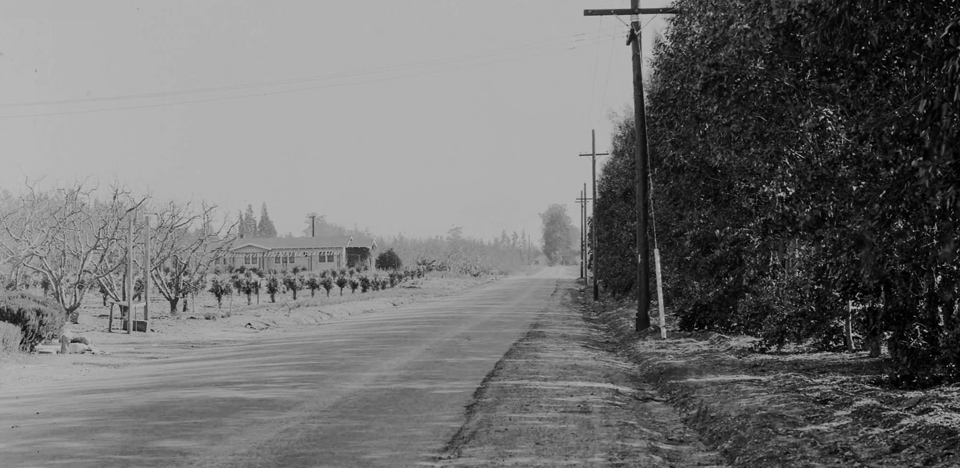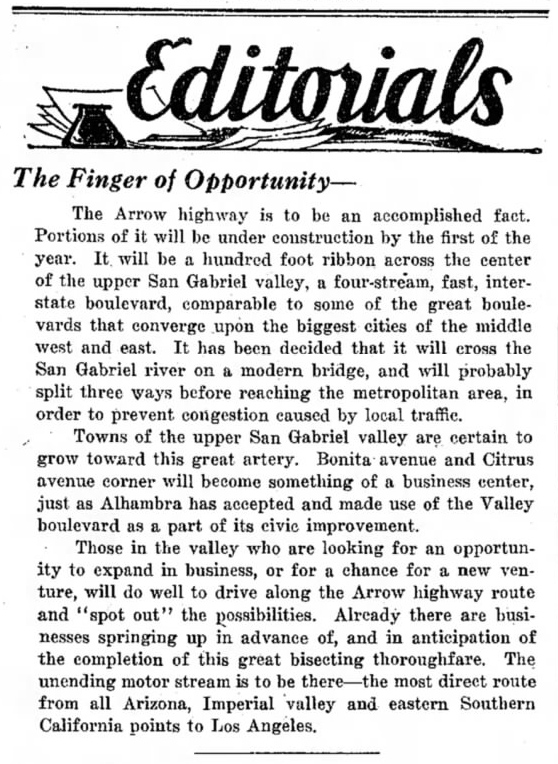One-hundred years ago today–March 20, 1924–the "Arrow Route Association" was formed at the Sycamore Inn in Upland1,2 to promote the development of a modern 80-foot-wide2 interurban highway from San Bernardino to Los Angeles. It was proposed to relieve traffic on Foothill Boulevard while also linking the business districts of Rialto, Fontana, Cucamonga, Upland, Claremont, La Verne and San Dimas.1,2 The ambitious initial plans even called for the new thoroughfare to extend beyond Los Angeles to Santa Monica.3


A pleasant rural stretch of the early Arrow Route in Cucamonga, San Bernardino County, 1933. (The approximate location today.)
Photos courtesy Darin Kuna and Huntington Digital Library.
In Covina at that time, the existing main boulevards to Los Angeles–Foothill and Valley–were 3 and 7 miles away from town respectively; not exactly convenient. The Arrow Highway, however, was to pass only a mile north of Covina, so community leaders were very much for the idea right from the start. Accordingly, on November 6, 1924, Covina's own J. L. Matthews was appointed chairman of a committee to oversee Arrow's completion west from La Verne to El Monte, where it was to intersect Valley Boulevard.4
Matthews, significantly, was also the publisher of the city's most influential newspaper, which he used as a platform to actively booster the plan. In this editorial, it's clear he could hardly contain his enthusiasm.

Covina Argus, September 30, 1927.5
Ironically, it would be landowners in the Covina area who would erect most of the procedural roadblocks that impeded Arrow Highway's eventual completion.
What today we call "NIMBY" was very much a force to be reckoned with even a century ago. Early on, in jurisdictions to the east of Covina, many objections were raised to the intended straight-line Arrow Route and demands made for its realignment.
Most notably, Claremont was understandably opposed to a 4-lane highway bisecting its college campus, and La Verne protested that it could not afford the $150,000 grade crossing required for the new arterial road to safely and efficiently pass over the tracks of the Santa Fe and Pacific Electric railways that lay south of town.6 Nonetheless, in spite of the many delays and diversions, Arrow Highway was completed from San Bernardino to the Los Angeles County line by 1930,7 and on the Temple City side, the westernmost section of Arrow Highway linking to Los Angeles was also completed in 1930 with the opening of a temporary bridge over the San Gabriel River.8

Route of Arrow Highway in San Bernardino County, 1932.
Map of Los Angeles and Vicinity (detail), Automobile Club of Southern California, courtesy Kevin Walsh.
Click on image for an enlargement.
However, it was the proposed sections north of Covina along Bonita Avenue that proved the most contentious and time-consuming of all to complete. Progress was delayed into the mid-Thirties by concerted actions of well-to-do grove owners along Bonita who submitted petition after petition to the County to protest the road's widening.9,10,11
New bridges for the Covina stretch of Arrow Highway also held up progress. Funding for concrete spans over the Little Dalton and Big Dalton washes wasn't approved until 1932,12 the wide San Dimas Wash near Arrow's intersection with Grand Avenue would not be bridged and bypassed until after World War II,13 and construction of a permanent bridge over the San Gabriel River was delayed until 1950.14
Simply improving the road to accommodate suburban traffic loads took years longer than expected, as well. It wasn't until late 1956 that the last segment of Arrow in Covina was widened from 2 lanes to 4 between Azusa Avenue and Citrus,15 and 1961 to finish the road's present alignment between San Dimas and La Verne.16 Only then was the western portion of Arrow Highway finally complete: a full 37 years after the much-ballyhooed San Bernardino-to-Los Angeles road project was first proposed.

Route of Bonita Avenue prior to its conversion to Arrow Highway, 1932.
Map of Los Angeles and Vicinity (detail), Automobile Club of Southern California, courtesy Kevin Walsh.
Click on image for an enlargement.
It was all too little too late, in any case. By 1933, the State of California had already made good on Arrow Highway's failed promises by completing the Arroyo-Garvey express line over the San Jose Hills to Los Angeles.17 Arrow would continue to serve motorists as an alternate route to other arterial roads, but the grand vision of its founding fathers simply never materialized, and it evermore remained a "highway" in name only.
Grateful thanks to Darin Kuna and Kevin Walsh for their helpful assistance with visuals for this article.

References:
1 Pomona Progress, March 21, 1924, p.1.
2 Pomona Bulletin, March 21, 1924, p.6.
3 Pomona Bulletin, April 11, 1924, p.12.
4 Pomona Progress, November 8, 1924, p.3.
5 Covina Argus, September 30, 1927, p.3.
6 Covina Argus, August 21, 1925, p.5.
7 Covina Argus, December 12, 1930, p.1.
8 Monrovia Post-News, August 8, 1930, p.1.
9 Covina Citizen, September 3, 1931, p.1.
10 Covina Citizen, February 25, 1932, p.1.
11 Covina Citizen, June 22, 1934, p.9.
12 Covina Citizen, August 18, 1932, p.1.
13 Historic Aerials.
14 Covina Argus-Citizen, April 21, 1950, p.10.
15 Covina Argus-Citizen, March 15, 1956, p.7.
16 Pomona Progress-Bulletin, April 1, 1961, p.6.
17 California Highways and Public Works, July-August, 1933, p.18-20.
Clipping from Newspapers.com.
No comments:
Post a Comment
To post a comment, you must login to this page with the Google Chrome web browser. That is the only way that works now.